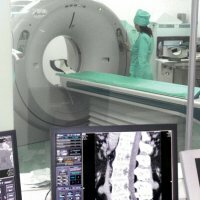Radiation diagnosis of the pancreas

The pancreas carries two functions in our body: it is external secretion( ensuring normal digestion) and internal secretion, which ensures the production of an insulin hormone that enters the bloodstream and is necessary for assimilation of sugar by the cells of the body.
Modern methods of radiation diagnosis
Modern medicine has achieved significant success in the diagnosis of diseases of the abdominal cavity, through the use of a number of methods of radiation diagnosis.
Radiodiagnosis today is significantly different from the radiographic study of the past. For decades, the methods of radiation diagnosis have been improved and updated.
The possibilities for assessing the state of the pancreas are quite large today. Ultrasound, MRI, CT occupy the main role in modern medicine.
In many patients, radiation diagnosis can determine the shape, size, contours, position, condition of the organ tissues, pathological changes, and also the effect on the pancreas of nearby organs.
It should be noted that modern methods of radiation diagnostics help doctors to establish the effectiveness of the treatment and the complications that have arisen.
The most popular methods of radiation diagnosis of the pancreas are: X-ray, ultrasound, computed tomography, endoscopic examination of the duct system of this organ.
Radiodiagnosis is used for diagnostic imaging and provides an opportunity to see a clear picture of the disease.
Modern diagnostics help to see a possible increase in the size of the pancreas or the presence of concrements.
Radiography
With standard radiography it is impossible to see volumetric neoplasms. Tumors of the pancreas are diagnosed with MRI, CT or ultrasound.
US
Ultrasound examination of the pancreas has become an important stage in various clinical situations. Detect the foci of tissue necrosis helps ultrasound of this organ.
Additional methods of radiodiagnostics
In addition to the basic methods of radiation diagnosis of the pancreas, there are additional methods that allow more accurate determination of the condition of the organ and make a final diagnosis. The correct definition of the diagnosis allows the doctor to prescribe the most optimal treatment.
Additional methods of radiation diagnosis are fluoroscopy and radiography of other organs, which directly or indirectly can affect the state of the pancreas.
Recently, digital subtraction digital arteriography has often been used to diagnose a disease.
Sometimes intravenous cholegraphy is used in medical institutions, which can help in the diagnosis of pancreatic disease.
Radiation diagnosis of neoplasms
Malignant diseases of the pancreas have increased in recent years. However, it should be noted that the tumor in the area of this organ in most cases is determined by radiation diagnosis in the late stages.
For a complete and correct diagnosis of pancreatic neoplasms, a comprehensive study is required.
The results of the study create a complete picture of the existing disease. The size of most malignant neoplasms of the pancreas is about 40 mm. Ultrasound diagnosis allows you to determine the contours and shape of the tumor. With the help of ultrasound it is impossible to recognize this malignant or benign neoplasm.
Proper treatment of patients with pathological changes in the pancreas is fully dependent on timely and accurate diagnosis. Radiation diagnosis is of no small importance in the treatment process.
The use of modern technologies in the field of radiation diagnosis allows timely treatment and ensures a successful outcome of pancreatic diseases.
All radiological investigations are carried out by medical specialists in medical institutions.



